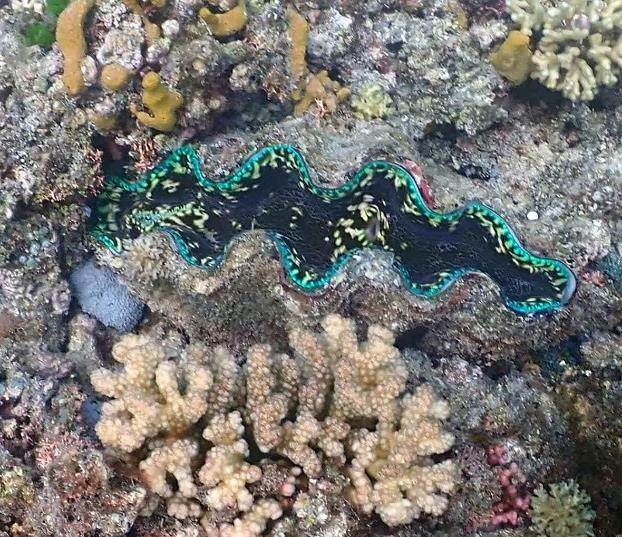© 2011-2025 The Avataric Samrajya of Adidam Pty Ltd, as trustee for the Avataric Samrajya of Adidam. All rights reserved.
Posted November 2021

From the vast numbers of old giant clam shells scattered across Naitauba Island–lining the paths and roadways and in heaps on the floor of the lagoon–we know that clams once numbered in the thousands on Naitauba’s reef. Those clams were harvested relentlessly for food and for their shells until they were brought to the brink of extinction.
Now, these unique and beautiful creatures are protected everywhere on the Naitauba reef. With the assistance of Fiji’s Ministry of Fisheries, we are supporting the giant clams to regenerate their population.
The yearly spawning season for giant clams is October and November. We know from the scarcity of young clams on the reef that the spawning season has not been productive for many years. This is because the clams are too widely scattered for fruitful spawning. Nearly all the giant clams we now find are mature adults who cannot reproduce unless they are near other clams which they can fertilize with each other’s spawn.
To address this situation, we have been working with Fiji’s Ministry of Fisheries to raise juvenile clams to be placed in clusters out on the reef. This project will eventually produce results once the juveniles become sexually-mature adults. However, we have also been using a more direct approach, which involves aggregating the adult clams already on the reef into clusters to help them reproduce. Being placed in proximity allows mutual fertilization to produce new clams.
Several years ago, we began an experiment by gathering about 20 giant clams into a cluster on the west side of the island. We snorkeled along the reef until we spotted a giant clam, free-dived to the bottom, and muscled it across the sea floor to its nearest neighbor. Then we scanned the area to find more clams to add to the cluster. We saw the potential in this approach but also recognized that we need to do it on a larger scale to make it effective.

This year we have gathered over 150 giant clams into over 20 clusters of four to eleven clams each, potentially making this spawning season the most productive in many years.
Spawning clams release billions of sperm and eggs, only a tiny fraction of which become clam larvae. These larvae swim about freely in planktonic form for several weeks, slowly growing a shell and sinking to the bottom, eventually to grow into a giant clam. Only a tiny fraction of the larvae survive the transition to a clam. Countless numbers of larvae become food for other reef creatures. It is the miniscule fraction that do grow into mature clams that are the basis for re-growth of Naitauba’s giant clam population. We do not know yet how many new clams will emerge on the reef, but the process of regeneration has begun.

© 2011-2025 The Avataric Samrajya of Adidam Pty Ltd, as trustee for the Avataric Samrajya of Adidam. All rights reserved.